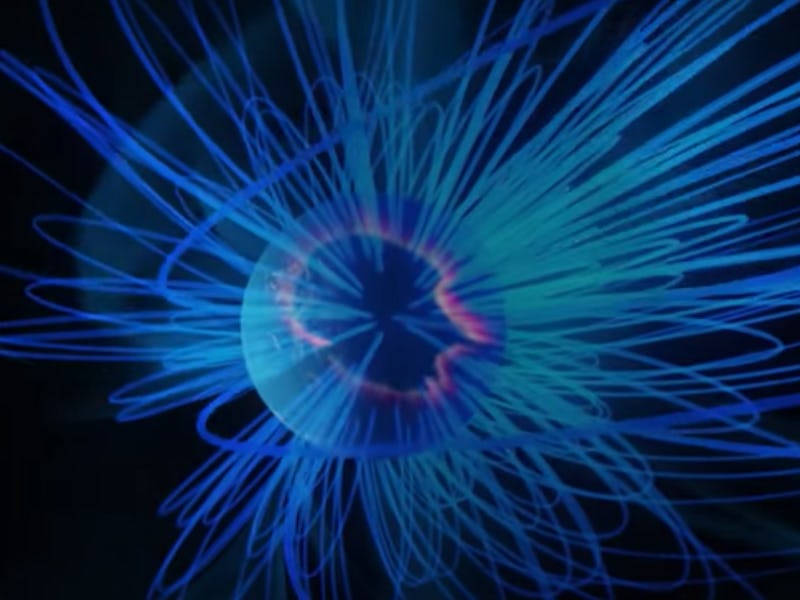These trippy Martian visuals hold clues to why the planet lost its atmosphere
A small spacecraft mapped the electric currents around Mars for the first time.

During its early history, Mars may have once been a habitable planet instead of the dry, desolate world it is today. That may be because throughout the billions of years of its existence, Mars' atmosphere has been leaking into space.
In order to better understand why Mars lost its atmosphere, scientists set out to map Mars' electric currents in the Martian atmosphere that may be responsible for letting the gas in its atmosphere slip away.
Using NASA's Mars Atmosphere and Volatile Evolution (MAVEN) spacecraft, a team of researchers has mapped out the electric current systems in Mars' atmosphere for the first time, resulting in some psychedelic visualizations that helped scientists determine what was driving the atmosphere to escape into space.
The findings are detailed in a study published Monday in the journal Nature Astronomy, which suggests that solar wind that constantly flows from the Sun is the main driving force behind the atmospheric escape of the Red Planet.
“These currents play a fundamental role in the atmospheric loss that transformed Mars from a world that could have supported life into an inhospitable desert,” Robin Ramstad, experimental physicist at the University of Colorado, Boulder, and lead author of the new study, said in a statement.
The researchers were hoping to discover how essential a magnetic field is to the regulation of a planet's atmosphere.
While Earth has a magnetic field, Mars does not. Instead, charged particles released from the upper atmosphere of the Sun, known as solar wind, interact with Mars' atmosphere and create an induced magnetosphere, or the area of space that surrounds a planet.
Solar wind constantly flows from the Sun at a speed of approximately one million miles per hour.
Scientists are aware of Mars' magnetosphere, but they were yet to understand how it influences its atmosphere, and how much energy is transferred from the solar wind that would drive atmospheric escape.
The data shows the solar wind and magnetic field wrapping around Mars, almost like throwing a handful of spaghetti noodles onto someone's face.
A visualization of Mars' electric currents as they envelop the Red Planet.
In a second visualization, scientists used the data from MAVEN to map the electric currents around Mars. The image shows the electric currents cupping the Red Planet's dayside and flowing into its nightside. These loops of electric currents connect Mars' upper atmosphere and its induced magnetosphere to the solar wind.
As the ions and electrons of the solar wind smash into Mars' induced magnetic field, they are forced to flow apart due to their opposite electric charge with some ions flowing in one direction while some electrons flow in the other direction. This results in the drape-like formation of the electric currents around Mars from the dayside to the nightside of the planet.
Meanwhile, x-rays and ultraviolet radiation emitted from the Sun are constantly ionizing areas of Mars' upper atmosphere, causing it to be able to conduct electricity.
“Mars’ atmosphere behaves a bit like a metal sphere closing an electric circuit,” Ramstad said.
This process is essentially responsible for Mars' atmospheric escape.
The currents induced in the solar wind transform the energy of the solar wind into magnetic and electric fields that accelerate the charged particles of Mars' atmosphere, which causes the planet's atmosphere to leak into space.
Mars' unfortunate before and after photo.
Without a magnetic field, Mars has been losing its atmosphere for billions of years and transforming from a wet, warm habitable world to a cold, dry desert.
MAVEN was launched in November, 2013 to study the Red Planet's atmosphere, climate and its past habitability.
Abstract: Induced magnetospheres form around conductive non-magnetized planetary objects (such as the ionospheres of Mars, Venus, Titan, Pluto and comets) in the electrodynamic interaction with a magnetized flowing plasma, such as the solar wind. The resulting induced currents couple the ionosphere and the deflected plasma, thus they provide insight into the solar wind’s role in powering the heating, escape and evolution of planetary atmospheres. In contrast to the analogous current systems in intrinsic magnetospheres, which were mapped decades ago at Earth, the current systems of induced magnetospheres are largely unexplored. Here, we use five years of magnetic field measurements from the Mars Atmosphere and Volatile EvolutioN (MAVEN) orbiter to empirically map the current systems of the Martian induced magnetosphere. We find unexpected features, in particular: coupling of the ionosphere and the bow shock, asymmetries between the north–south electric hemispheres and a twist in the near-Mars current system. The current flow pattern in the induced magnetosphere of Mars indicates a system driven by a magnetospheric convective electric field, powered by the solar wind interaction.